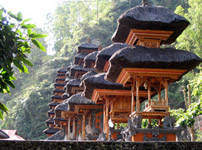 Balinese temple design is a fascinating subject in its own right. Everything from the layout, to the structures to the decoration has a specific function. Locally geography often determines the actually shape of a temple and no 2 temples are exactly the same. There are however certain key elements that you will find in most temples. The diagram shows how a temple is often split into 3 sections, the outer, middle and inner courtyards. Inside these courtyards are shrines and other structures to enable people to worship.
Balinese temple design is a fascinating subject in its own right. Everything from the layout, to the structures to the decoration has a specific function. Locally geography often determines the actually shape of a temple and no 2 temples are exactly the same. There are however certain key elements that you will find in most temples. The diagram shows how a temple is often split into 3 sections, the outer, middle and inner courtyards. Inside these courtyards are shrines and other structures to enable people to worship.
(click on temple diagram for labeled version)
Just as a Balinese family compound will be built on the kaja-kelod axis, so too are Balinese temples. Larger temples have 3 courtyards, smaller ones just 2.
The entrance to a Balinese temple at the kelod (pointing away from Gunung Agung) end of the compound, is often a simple gate. The first courtyard is the outer courtyard, which is the realm of humans. Here temple dances will often occur and tourists will be allowed to visit this part of the temple. During ceremonies food stalls may be set up here and cockfighting may take place. The outer courtyard is called the jaba.
The jaba tengah, or middle courtyard is a halfway step between the realm of humans and the realm of the Gods. This are is used for preparing offerings.
The jeroan, or inner courtyard is sacred and is where all the important shrines are located. Some temples will allow properly dressed tourists into the inner courtyard, sometimes not. Offerings are brought to the inner courtyard, the most important dances are performed there and all temple rituals and prayers are performed there.
 Passing through the different sections of a temple, the portals get more impressive. Starting with the plain outside gate, a person can pass into the middle courtyard via a candi bentar, the impressive Balinese split-gate. From there to the inner courtyard one has to pass through a kori agung, which is a stone-capped gate. Often there will be a flat block of cement (aling aling) directly inside the kori agung, blocking the way, forcing those entering to walk around either side. This is to keep evil spirits out of the jeroan, as spirits can only walk in straight lines.
Passing through the different sections of a temple, the portals get more impressive. Starting with the plain outside gate, a person can pass into the middle courtyard via a candi bentar, the impressive Balinese split-gate. From there to the inner courtyard one has to pass through a kori agung, which is a stone-capped gate. Often there will be a flat block of cement (aling aling) directly inside the kori agung, blocking the way, forcing those entering to walk around either side. This is to keep evil spirits out of the jeroan, as spirits can only walk in straight lines.
Common features found inside a temple are bales, the open sided pavilions with raised seating section and thatched roof. These have a variety of uses including a place for the gamelan orchestra to sit, village meeting and a resting place for worshipers. Another common feature are gedong, or square shaped brick shrines capped with a thatched roof. These have specific names and are in honor or a particular ancestor, such as the village founder, or a specific deity, such as meru Sanghyang Widi Wasa, the supreme deity.
Outer Courtyard (jaba) structures:
•Bale – An all purpose pavilion used for meetings.
•Bale Gong – This is the gamelan pavilion where the orchestra plays and instruments are stored.
•Kulkul – A bell tower with a split-log hanging in the center. Used to summon people.
•Candi Bentar – Split gate which separate the outer courtyard (jaba) from the middle courtyard (jaba tengah).
Middle Courtyard (jaba tengah) structures:
•Paon – kitchen located in a open-sided pavilion. Used for preparing offerings.
•Wantilan – A large pavilion used for dance performances.
•Kori Agung – Stone capped gate separating the middle courtyard (jaba tengah) from the inner courtyard (jeroan).
Inner Courtyard (jeroan) structures:
•Bale Piasan – Pavilion where offerings are placed.
•Taksu – A stone pillar which is the seat of the interpreter to the gods. During certain trance dances this interpreter will occupy the body of the dancer.
•Meru Gunung Batur – A shrine dedicated to Mt. Batur. Has from 1-9 thatched roofs.
•Gedong Maospahit – Shrine honoring the ancient Majapahit people from Java, the ancestors of the modern day Balinese Hindus. Identifiable by the deer head sculpture.
•Padmasana – The Lotus Throne, seat of Sanghyang Widi Wasa, the Supreme Deity. Always located in the kaja-kangin corner of the courtyard, which is the closest point to Gunung Agung. Also identifiable because the whole structure sits on the back of a giant cosmic turtle, the Bedawang.
•Meru Gunung Agung – Shrine dedicated to Mt. Agung. From 3-11 roofs.
•Meru Sanghyang Widi Wasa – Shrine dedicated to the supreme deity. Has 11 thatched roofs.
•Gedong Pesimpangan – Shrine in honor of the founder of the village.
•Gedong Paruman – A pavilion structure in the center of the inner courtyard, left empty so the gods can assemble for ceremonies.